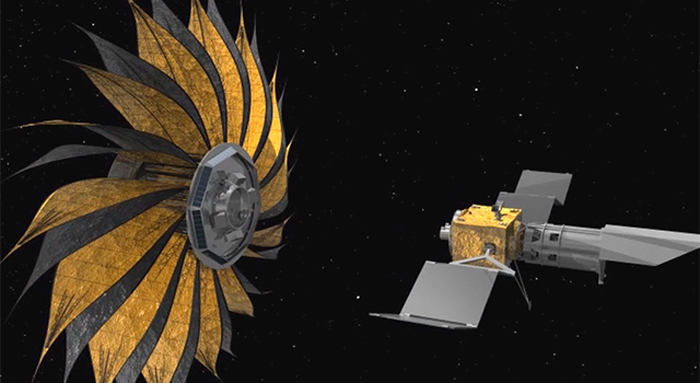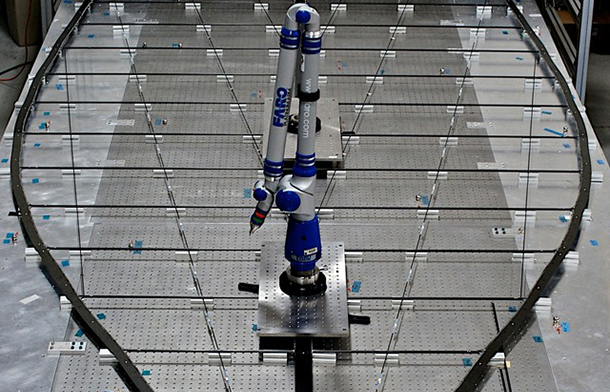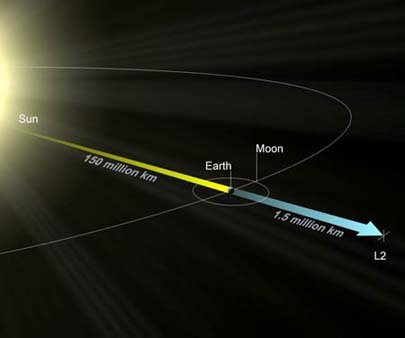.
21.03.2014

This animation shows the prototype starshade, a giant structure designed to block the glare of stars so that future space telescopes can take pictures of planets.
.
A spacecraft that looks like a giant sunflower might one day be used to acquire images of Earth-like rocky planets around nearby stars. The prototype deployable structure, called a starshade, is being developed by NASA's Jet Propulsion Laboratory in Pasadena, Calif.
The hunt is on for planets that resemble Earth in size, composition and temperature. Rocky planets with just the right temperature for liquid water -- not too hot, not too cold -- could be possible abodes for life outside our solar system. NASA's Kepler mission has discovered hundreds of planets orbiting other stars, called exoplanets, some of which are a bit larger than Earth and lie in this comfortable "Goldilocks" zone.
Researchers generally think it's only a matter of time before we find perfect twins of Earth. The next step would be to image and characterize their spectra, or chemical signatures, which provide clear clues about whether those worlds could support life. The starshade is designed to help take those pictures of planets by blocking out the overwhelmingly bright light of their stars. Simply put, the starshade is analogous to holding your hand up to the sun to block it while taking a picture of somebody.
The proposed starshade could launch together with a telescope. Once in space, it would separate from the rocket and telescope, unfurl its petals, then move into position to block the light of stars.
The project is led by Jeremy Kasdin, a professor at Princeton University, N.J., in conjunction with JPL and support from Northrop Grumman of Redondo Beach, Calif.
.
The flower you see in this animation isn’t NASA’s attempt to celebrate the coming of spring. It’s actually the latest design in a cutting-edge effort to take pictures of planets orbiting stars far from the sun.
Astronomers have been indirectly detecting exoplanets for more than 15 years, but actually taking a picture of one has proven an immensely difficult task. Picking out the dim light of a planet from a star billions of times brighter is akin to finding a needle in a cosmic haystack, especially when the planet in question is a small, rocky world similar to Earth. In order to achieve this feat, researchers are developing techniques to block out the starlight while preserving the light emitted by the planet. This is called starlight suppression.
It’s a task that NASA’s flower-shaped starshade is designed to make easier. Working in conjunction with a space-based telescope, the starshade is able to position itself precisely between the telescope and the star that’s being observed, and can block the starlight before it even reaches the telescope’s mirrors.
With the starlight suppressed, light coming from exoplanets orbiting the star would be visible. Using this technology, astronomers would be able to take actual pictures of exoplanets – images that could provide clues as to whether such worlds could support life as we know it.
The flower-shaped petals are part of what makes the starshade so effective. “The shape of the petals, when seen from far away, creates a softer edge that causes less bending of light waves,” said Dr. Stuart Shaklan, JPL’s lead engineer on the starshade project. “Less light bending means that the starshade shadow is very dark, so the telescope can take images of the planets without being overwhelmed by starlight .”
The starshade is also unique in that, unlike most space-based instruments, it’s one part of a two-spacecraft observation system. “We can use a pre-existing space telescope to take the pictures,” explains Shaklan. “The starshade has thrusters that will allow it to move around in order to block the light from different stars.”
This process presents a number of engineering challenges that Shaklan and his team are working hard to unravel, from positioning the starshade precisely in space, to ensuring that it can be deployed accurately. “Our current task is figuring out how to unfurl the starshade in space so that all the petals end up in the right place, with millimeter accuracy,” said Professor Jeremy Kasdin, a Princeton researcher who is the Principal Investigator of the starshade project. Kasdin’s group will create a smaller scale starshade at Princeton to verify that the design blocks the light as predicted by the computer simulations. Concurrently, the JPL team will test the deployment of a near-full scale starshade system in the lab to measure its accuracy.
Despite these challenges, the starshade approach could offer planet-hunters many advantages. “One of the starshade’s strengths is simplicity,” said Kasdin. “Light from the star never reaches the telescope because it’s blocked by the starshade, which allows the telescope system to be simpler.” Another advantage of the starshade approach is that it can be used with a multi-purpose space telescope designed to make observations that could be useful to astronomers working in fields other than exoplanets.
NASA’s starshade engineers are optimistic that refining their technology could be the key to major exoplanet discoveries in the future. “A starshade mission would allow us to directly image Earth-size, rocky exoplanets, which is something we can’t do from the ground,” says Kasdin. “We’ll be able to show people a picture of a dot and explain that that’s another Earth.”
Quelle: NASA
.
Update: 19.05.2014
.
Starshade Could Help Photograph Distant Planets
.
As a planet orbits near its sun, the bright stellar light interferes with observations made from Earth. To block the excess light, NASA scientists want to launch into space a large instrument called a starshade that will allow a space telescope to directly image an Earth-sized planet in an Earth-like orbit.
“A starshade removes most of the starlight by blocking it outside the telescope. It creates a shadow much like the Moon does during a solar eclipse,” said Jeremy Kasdin of Princeton University in an email.
Kasdin is the principal investigator of NASA’s starshade project.
“By choosing the size and shape and distance just right, it can block the starlight while letting the planet light pass by.”
.

A prototype of one of the petals that will form a starshade that will help image planets outside of the solar system. Credit: Doug Lisman
.
A telescope in bloom
Resembling a giant sunflower, a starshade, or external occulter, operates in space separately from the observing telescope. Ideally, the pair would travel in a special area known as the second Lagrangian point, a region 930,000 miles (1.5 million kilometers) from Earth, outside of the orbit of the Moon. As the telescope points toward a distant star, it peers over the sharp edge of the petals, which block the stellar light and allow scientists to directly image distant planets.
Developing the occulter brought a number of engineering challenges. The design had to be created and modified to precisely block the incoming light. This meant developing a material that minimizes the glint from the distant starlight.
Unlike most space-based instruments, the starshade and telescope are two separate pieces that require precise alignment, creating another hurdle.
“We have to design and build a very large deployable starshade that could be controlled to stay in line with the telescope to sub-meter accuracy,” Kasdin said
At present, engineers are building prototypes of various parts, constantly testing accuracy and deployment. The team recently tested the massive petals to ensure that they lay correctly every time.
When the mission is ready to launch, the 110-foot (34-meter) starshade would fold up small enough to fit into a launch vehicle. Once positioned in an Earth-leading orbit, the 28 massive petals would bloom and the occulter would hold a rigid, unmoving form.
The starshade, which will sit 23,000 miles (37,000 kilometers) from its companion telescope, won’t be able to undergo a simultaneous test of all components while earthbound.
“We can’t do a typical ‘end-to-end’ test. We can’t shine light past it and see a shadow,” Kasdin said. “However, we can do a lot of other tests to confirm it works.”
Such tests include measuring all of the key properties such as the shape, deployment accuracy, and thermal stability. Tests on the individual subsystems will also be performed. According to Kasdin, this approach has been used quite often on other space systems.
“Sometimes you simply can’t fully test something without going into space,” he said.
Seeking the holy grail
NASA’s Kepler Telescope spotted the dips in starlight that occur when a planet moved between Earth and its sun. The slight dimming allowed scientists to calculate a number of properties about the planet, but was not a direct observation. The upcoming James Webb telescope will work similarly.
A telescope linked to a starshade, however, should be able to directly photograph a distant planet, which will lead to more in-depth studies about the distant body
“We need to find efficient ways to study that very small amount of light, so we can say something about whether there might be water on that planet, carbon dioxide, or other important atmospheric gases,” said Margaret Turnbull, of the Global Science Institute in Wisconsin, in an email.
“When we have that kind of information, we will be able to make statements about whether such a planet could be habitable for life as we know it on Earth.”
She went on to call the starshade “a mission that is seeking the ‘holy grail’ of exo-Earth detection.”
In its first 18 months, the starshade should enable its telescope to study 55 stars. Its precision will allow its telescope to detect Jupiter-sized planets around all the stars, with the possibility of detecting Earth-analog planets around 22 others. The remaining 18 months would allow the pairing to revisit stars and obtain more detailed observations.
The starshade serves as one part of a two-piece mission, with the telescope forming the other crucial half. The instrument can work with any telescope, though high-quality optics will capture the best data. Because the starshade filters out the light before it even reaches the optical device, it can work with simpler telescopes that omit several technical components, as well as instruments smaller than even the Hubble Space Telescope, said Kasdin.
.

The second Lagrangian point, or L2, is a region of space where the gravitational forces of the sun and Earth balance the centrifugal effects of a starshade—or any other body—in orbit. This is the ideal location for the proposed occulter. Credit: STScI
.
In addition to imaging far-off planets, the telescope flown with the starshade should be able to perform other sorts of astronomical research. As the observing target changes, the starshade will use thrusters to shift its position, a process that can take up to two weeks. Rather than sitting idle, the adjacent telescope could perform research beyond planet searching.
“With the starshade moving from target to target, about half the mission lifetime would be available for general astrophysics science programs,” Turnbull said.
A starshade also has the possibility to improve planned missions, such as NASA’s Wide-Field Infrared Survey Telescope (WFIRST), a proposed observatory that would hunt for and directly image planets outside the Solar System, as well as search for dark matter.
“If a starshade could be flown with, say, WFIRST, then that would completely change the landscape and allow for incredible science both in exoplanets and many, many other areas of astrophysics,” Turnbull said.
The time required to reposition the starshade is one of its biggest drawbacks. The mission would also be restricted by the amount of fuel carried by the occulter.
“We have to design an incredibly efficient path across the sky that intersects the most interesting targets and uses the least amount of fuel,” Turnbull said. “Sometimes that means passing up one interesting target in order not to lose other interesting targets.”
However, Turnbull thinks the science generated by such a mission would reap rewards beyond the scientific data.
“When the public can get excited about a NASA mission seeking something as relatable and tangible as another Earth-like planet, then that benefits the field as a whole, including research efforts that might seem more esoteric to the public,” she said.
.
Quelle: ASTROBIOLOGYMAGAZINE
5573 Views
